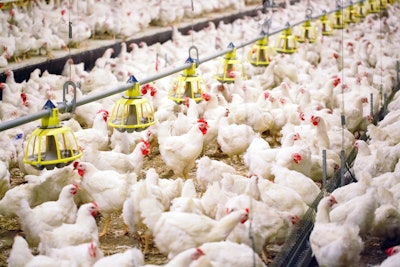
Highly pathogenic avian influenza (HPAI) remains an absolute menace for the U.S. turkey and egg industries, but cases in the broiler sector have been very few and far between.
Disease problems, however, are legion beyond HPAI, with Newcastle disease, coccidiosis, colibacillosis, infectious bronchitis and necrotic enteritis all common threats that broiler flocks face, just to name a few. Integrators make extensive use of in-house, and occasionally external, veterinary services to try and prevent, or at least mitigate, the negative effects brought on by disease outbreaks.
For most of the diseases that broiler flocks commonly encounter, the lethality rate is much lower than with HPAI, but severe and widespread flare-ups, as anecdotal reports suggest were happening earlier this year, can still weigh heavily on livability and overall flock performance.
Measuring livability
The U.S. Department of Agriculture (USDA) provides official monthly estimates for the number of broiler chicks hatched per month as well as the number of broilers slaughtered under federal inspection. A straightforward method of calculating livability is simply taking those slaughter estimates as a percent of chicks hatched, with a small time lag adjustment to hatchings to account for the average growout time of a typical broiler flock. This captures all mortality from the hatchery to the processing plant, including birds culled for various reasons on top of mortality from natural causes.
Significant progress was made at keeping birds alive from the industry’s earliest days through the 1980s, but over the past three-plus decades, livability rates have trended sideways overall. There continue to be ebb-and-flow cycles around a relatively stable baseline, presumably a function of breeder flock rotations and their downstream effects on chick quality as well as aforementioned disease issues. The industry has not been able to drive total mortality below 5% over an extended period, implying peak livability of 95%.
Impact of decline
Part of the issue is that broiler flock livability was especially strong between mid-2022 and mid-2023.
It was estimated at 95.1% during Q3 of 2022, slipped to 94.3% during Q4 of that same year, but recovered to 94.7% during Q1 last year and advanced further to 94.8% during Q2. Livability slipped again during the second half of 2023 and declined further to 93.6% during Q1 of this year as rumors surfaced that the disease threat had escalated for several integrators.
With the June slaughter estimate still not official as of this writing, livability during Q2 was on track to be relatively stable with Q1, a possible indication the issue is stabilizing. Even with the situation not deteriorating further, year-over-year comparisons in slaughter were negatively impacted by nearly 1.2% during the first half of 2024 due to slumping livability.
Incidentally, the total number of chicks hatched during the first half of this year was on track to post a similar increase from 2023. Said differently, while leading indicators have been portending modest industry expansion, slumping livability has resulted in stagnant growth overall. It is clearly a frustrating issue for all parties but one that is likely to be resolved in time.

















